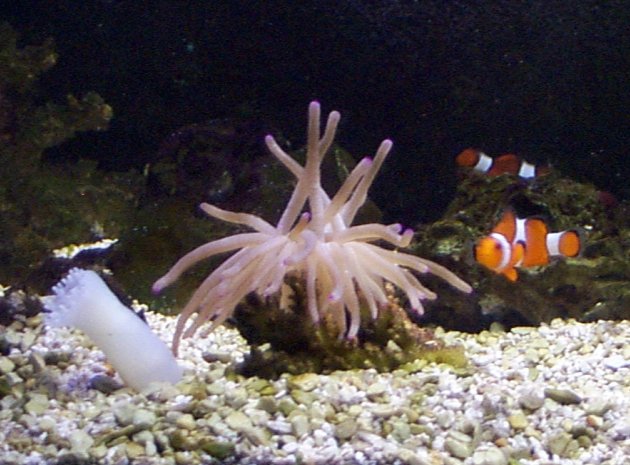 |
Percula Clownfish
 |
| Name: Percula Clownfish |
| Scientific name: Amphiprion percula |
| Range: Pacific and Indo Pacific regions |
| Habitat: Among the anemones, which are usually found attached to coral reefs or anchored in the sand |
| Status: non-endangered |
| Diet in the wild: live foods, such as plankton algae growing on reefs, and some shellfish |
| Diet in the zoo: flakes, pellets, and some live meat |
| Location in the zoo: James R. Record Aquarium |
| Physical description: There are hundreds of different types of clownfish, in a variety of colors that range from yellow to black to blue. The colors of the clownfish pictured above are orange with 2-3 white stripes around the body. These colors are the most common among the "typical" image of a clownfish. |
| Special anatomical,
physiological or behavioral adaptations:
The clownfish is best known for its ability to come in contact with the stinging tentacles of the sea anemone, and not be harmed. Not only are the clownfish not harmed by the anemone, they live among the sea anemone and use its tentacles as protection from enemies. The clownfish also feed the anemone by leaving waste that is left behind in its tentacles, or actually gathering the food. This is a perfect example of symbiosis, which is defined as being different species of the animal kingdom living off of each other. |
| Personal Observations: The exciting thing about studying this fish is that it comes in so many different sizes and brilliant colors. There seem to be hundreds of different markings and color combinations. It definitely makes it an eye-catching exhibit. Another thing that uniquely stands out is the active and aggressive nature of the fish. When watching them, it is definitely easy to see how they get their name. Looping through the waving hands of the anemone, they play tag with each other with seemingly endless energy. |
| Source Materials and Related Links:
http://www.aquariacentral.com/fishinfo/marine/clown.htm
Animal Behavior."Swimming and search behavior in clownfish, Amphiprion perideraion larvae." Coughlin, D.J., Strickler, J.R., and Sanderson,B. v.44. Sept. 1992. (427-40). National Wildlife. "Friends and Anemones." Kathryn, Winiarski. V.35. Apr./may 1997. (52-9). |
| Author Page: Danya Rojas |